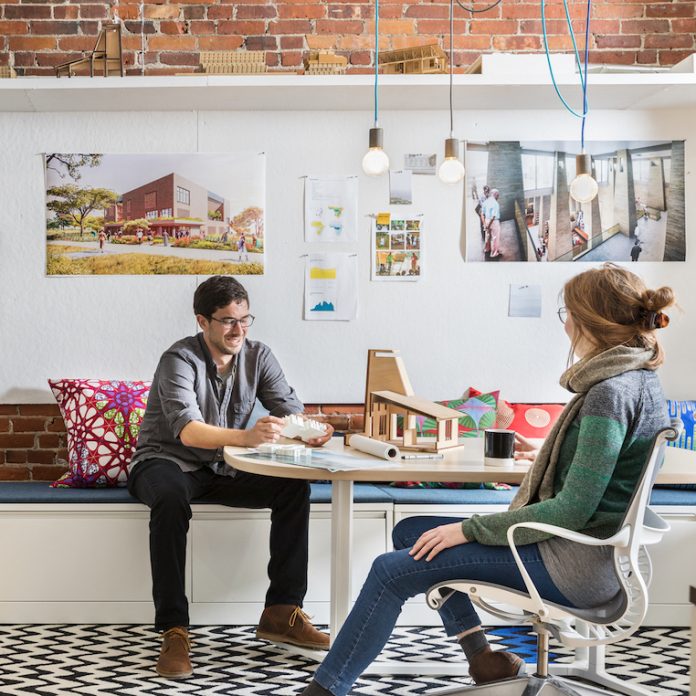
Remote working becomes distributed working – For the past year, most of us have been working, which is working outside of the offices. But as more offices reopen, it’s unlikely that everyone will simply head back to the office each day. What’s most likely is distributed working, which refers to how individuals and teams work across many locations (including the office) becomes the norm. Since many organizations have learned that their workers can, in fact, be trusted to be productive in almost any location, expect that workers will have the freedom to when and where they’d like for the forseeable future.
Offices reopen, but with more breathing room (phew!) – You know what’s not very popular during a pandemic? Sitting three feet from someone else trying to do their work. And guess what? It wasn’t very popular before the pandemic either. As distributed working becomes more normalized, expect the pressure to “densify” office floors with lots of small desks to be reduced – and for offices to gain some metaphorical and literal breathing room in the future.
Workplace wellness takes on a new meaning – Whereas physical ergonomics has always mattered to those with bad backs, eye strain, or carpel tunnel, the world is beginning to realize just how critical our places of work are to our cognitive and social health as well. Look for organizations to place a renewed emphasis on the workplace as a destination for socialization and culture building, along with quiet areas to focus and escape stress.
Facilities meets marketing – As employers offer people more autonomy to choose when and where they’d like to work, the office will increasingly be viewed as an “on-demand” resource. To better support positive employee experiences and ensure a good return on real estate investments, facilities teams will dial up the desirability of their spaces, focusing on understanding employee needs and offering positive experiences to keep employees happy and healthy.
Power to the people! End-user control becomes a priority – Since peoples’ work patterns have so drastically shifted in 2020, the tasks of designing future spaces can no longer easily be based upon past behaviors. As a means of embracing this uncertainty, and ensuring future flexibility, spaces will be designed to maximize end-user control, putting the power to adapt it in the hands of the employees with furniture, technology and even architecture that can be easily changed.
Fewer meetings; more chatting – collaboration technologies offer teams several ways to interact – posting in Teams or Slack channels, chatting via instant messaging, or in video meetings – and most of us have had enough video meetings to last us a long while. As teams become more comfortable with asynchronous collaboration (connecting at different times throughout the day rather than having everyone meeting simultaneously) and as reopened offices allow for more informal dialogue, our video fatigue will finally be remedied.
“Tier 2” cities start to pop – Big cities are awesome, but they’re also expensive and difficult to navigate for those commuting in from more affordable suburbs. As distributed working becomes more common, expect people to migrate towards more affordable locations that offer big-city amenities, which will provide new economic growth opportunities for these “tier 2” cities.
Work from home experiences get better – While most people enjoy the chance to work from home a few days a week, most of us didn’t enjoy being forced into exclusively working from home with little preparation. Look for those WFH experiences to improve as employers provide high-quality ergonomic seating, sit-to-stand desks, and critical technologies to employees for their homes. Reopened offices and coworking spaces will provide additional options for workers, and the reopening of schools will lessen the need for employees to simultaneously juggle working and parenting.
Outdoor work (and bringing the outdoors in) accelerate – One of the silver linings of working through a global pandemic is that many people rediscovered the physical, mental and emotional benefits of being outside. Look for both individuals and organizations to embrace outdoor working as a regular work experience and for the interior design of spaces to be inspired or mimic the great outdoors (what’s known as “biophilic” design).
Coworking comes to your block – The first wave of coworking may have had a few things wrong. Most spaces were located in the central business district of big cities and assumed that people would come in each day to work in an open environment with people from many companies. Instead, look for future coworking spaces to be located in residential centers, providing people the opportunity to escape down the road for an hour or a day when they need a time of focus or team interactions with nearby colleagues.
*By Ryan Anderson – Vice President – Global Insights and Research




































